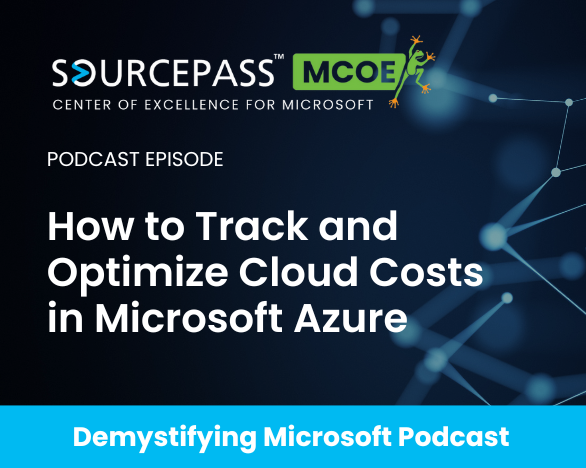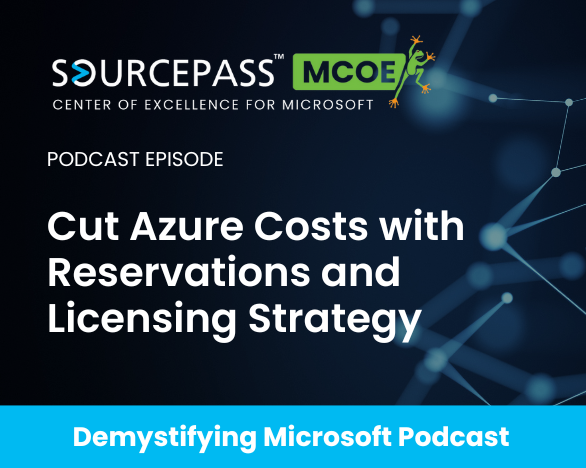6 min read
Microsoft Licensing Update: Windows 365 Cloud Apps Now in Preview
Microsoft’s Windows 365 Cloud Apps, now available in public preview, introduces a new way for organizations to deliver only the applications users...
3 min read
Nicole Walker
:
Jul 21, 2025 9:00:00 AM

Microsoft Azure cost management is the practice of monitoring, analyzing, and optimizing cloud spending to maximize operational efficiency and financial control. Azure’s consumption-based billing model means costs can escalate quickly if resources are not actively managed.
Effective cost management relies on understanding what is running in your environment, leveraging built-in tools like Azure Cost Management + Billing and Azure Advisor, and applying strategies such as rightsizing, cleaning up unused resources, and selecting optimal pricing models. Organizations that implement these practices gain visibility into their cloud spend, reduce waste, and improve ROI.
In this episode of Demystifying Microsoft podcast, Nathan Taylor (SVP, Global Microsoft Practice Leader at Sourcepass MCOE) explores the fundamentals of Azure cost management, including how consumption-based billing works, why costs can increase unexpectedly, and what practical steps organizations can take to control spending. The discussion covers the importance of visibility, the role of partners in cost management, and actionable strategies for ongoing optimization.
Azure cost management is a suite of tools and practices designed to help organizations monitor, analyze, and optimize their cloud spending. It provides visibility into resource usage, enables budgeting and forecasting, and supports ongoing optimization through recommendations and automation. With cloud costs often fluctuating due to dynamic resource usage, cost management is essential for maintaining financial control and maximizing the value of cloud investments.
Azure Cost Management + Billing consolidates billing data from all subscriptions, offering real-time tracking and detailed breakdowns by resource group or custom tags.
Azure Advisor provides actionable recommendations for rightsizing, cleaning up unused resources, and optimizing pricing models.
By integrating these tools into business and engineering workflows, organizations can proactively manage costs, avoid budget overruns, and ensure resources are aligned with actual needs.
Use Azure Cost Management + Billing to view real-time and historical spending across subscriptions. The platform provides breakdowns by resource, tags, and time period, helping you pinpoint where costs are rising and why. For deeper analysis, export data to tools like Power BI or Excel for custom reporting.
Azure Cost Management, Azure Advisor, and the Pricing Calculator are core tools. Cost Management offers dashboards and alerts, Advisor recommends optimizations, and the Pricing Calculator lets you model costs before deployment. Third-party solutions can add automation and advanced analytics.
Azure Cost Management’s forecasting feature uses historical usage to project future costs. You can set budgets and receive alerts when spending trends exceed expectations. For complex environments, combine Azure’s forecasts with external financial planning tools.
Regularly review resource usage, right-size VMs, remove unused resources, and use reserved instances for predictable workloads. Tag resources for accountability, schedule downtime for non-critical systems, and leverage Advisor’s recommendations for ongoing savings.
In Azure Cost Management, you can create budgets for subscriptions or resource groups. Configure alerts to notify you when spending approaches or exceeds your set limits. This helps prevent surprises and keeps teams accountable.
Azure Advisor flags underutilized or idle resources. Review its recommendations regularly, and automate shutdowns or resizing where possible to avoid unnecessary charges.
Managing cloud costs in Azure requires ongoing attention, technical insight, and the right tools. By understanding your environment, leveraging built-in cost management features, and applying proven strategies, you can gain control over your cloud spend and maximize the value of your investment. Staying informed and proactive is key to making decisions that benefit your organization.
For ongoing updates and practical insights on Azure cost management, subscribe to the Demystifying Microsoft podcast.
If you have questions about optimizing your cloud spend or want to discuss options for deploying cost-saving strategies, connect with the Sourcepass Center of Excellence for Microsoft for expert guidance and support.
Explore more in our Azure Cost Management series:

6 min read
Microsoft’s Windows 365 Cloud Apps, now available in public preview, introduces a new way for organizations to deliver only the applications users...

5 min read
Microsoft has introduced a combined security and compliance add-on for Business Premium subscribers, delivering enterprise-grade protection and...

6 min read
Microsoft Purview Suite for Business Premium is a compliance add-on for Microsoft 365 Business Premium that delivers enterprise-grade data...

Organizations using Microsoft Azure often face unpredictable cloud bills and wasted spend. The most effective way to reduce costs is to understand...

Cloud cost optimization in Azure isn’t just about visibility. It’s about precision. As environments scale and workloads evolve, the real challenge...

Changes to Microsoft’s licensing model this year will impact subscription costs, product configurations, and long-term planning for infrastructure...